Packaged Multizoneasaurus thrived primarily between 1960 and 1980 A.D. Habitat for this large heating and cooling beast typically consisted of rooftops in cool and temperate regions of the North American continent, where the length and severity of heating and cooling seasons are similar. Many can still be found in place today. Notably, its present-day counterparts consume far less energy, a process that took decades of evolution.
Usually, packaged multi-zone air handlers were installed at institutional facilities, schools, hospitals or banks and were selected based on their ability to provide simultaneous heating and cooling to different zones within the structure.
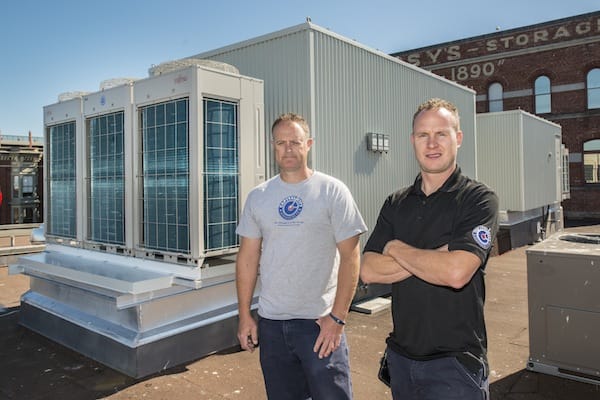
Tyler Little and Tim Sykes, of Capital City Refrigeration, in front of the custom air handlers they installed at the Rithert Building, in Victoria, BC.
As for comfort, the huge units did a good job. From an energy standpoint, there’s plenty of room for improvement.
These hot deck/cold deck air handling units use a large supply fan (and often a return fan as well) to force air through a chilled water or refrigerant coil and a hot water coil. On the supply side of the stacked coils, zone dampers on each take-off control and mix air for each zone.
Heritage building, vintage system
Victoria, BC has a climate well suited to multi-zone, rooftop air handlers. The area is known for temperate winters and mostly tolerable heat and humidity during the summer months. Long shoulder seasons also mean that heating and cooling requirements between the north and south side of a building can vary substantially: perfect for a system that can serve dissimilar zones.
One of the oldest structures in Victoria, the Rithet Building, was constructed in the late 1860s. It has, at the very least, two claims to fame. The prominent external cast iron columns make it one of British Columbia’s finest examples of West Coast Iron Front architecture. In the lobby, the focal point is a brick well that served as early Fort Victoria’s only water source.
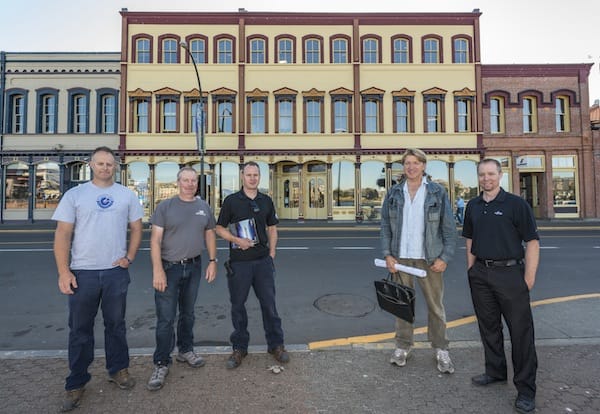
(from l to r) Tyler Little and Tim Sykes, of Capital City Refrigeration, Jay Bull of J.B. Sheet Metal, Tom Pedersen, engineering technologist at Avalon Energy Management and Refrigerative Supply’s Steve Chamut.
In the mid-1970s, ductwork was added to the 25,000-sq.-ft. brick building and three Lennox multi-zone packaged units, each roughly 30-feet long, were installed on the roof. One of these multi-zone units served only the upper floor and was recently replaced with seven York Affinity packaged rooftop heat pumps.
The other two old multi-zone units remained in service, each serving seven zones. Installed in 1993, four, 300 MBH HydroTherm Multitemp boiler downstairs provided ample hot water for the big heating coils, and each unit had an integral DX coil served by a multi-stage compressor.
Last year, the building’s current owner, Hobo Holdings, approached Avalon Energy Management, a mechanical engineering and energy consulting firm, about replacing the remaining two multi-zone units.
“The Rithet Building now contains offices with some retail space below, and it needed to remain fully occupied for the duration of any HVAC retrofit,” said Tom Pedersen, engineering technologist at Avalon. “The fact that it’s a Landmark Heritage Building further reduced our options when it came time to select a new system.”
Instead of overhauling the existing multi-zone rooftop units or replacing them with new versions of the same technology, Avalon designed a multi-zone air handler that employed air-to-air heat pump technology exclusively.
Drop-in replacement
“After looking at a few different options, we determined that new, custom-built air handlers would be best,” said Pedersen. “Unlike the originals though—which had only two coils—the seven fan coils inside the new units are served by VRF (variable refrigerant flow) condensers with a heat recovery feature for load sharing. The cost increase over a new factory multi-zone unit was marginal, but the difference in energy consumption was impressive.”

Tim Sykes and Tyler Little, co-founders of Capital City Refrigeration, check connections on a Fujitsu Airstage VRF systems.
Once settled on VRF equipment, Pedersen’s biggest design hurdle was static pressure; could the fans on the evaporator coils provide the air movement needed? Much of the existing ductwork was concealed and the mechanical “as-built” drawings were outdated and unreliable. After calculating the pressure loss based on these old drawings, Avalon took the extra precaution of hiring an air balancing company to determine the true pressure drop. Both the calculated pressure drops and the measured pressure drops fell within the manufacturer’s published capabilities for their high pressure fan coils of 0.4” to 1.0” wg. for each ducting run.
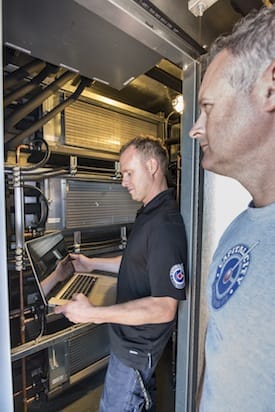
Tim Sykes and Tyler Little, co-founders of Capital City Refrigeration, pull data from a VRF fan coil.
Of the six or seven VRF manufacturers that Avalon was considering, the field was narrowed to three; Daikin, Fujitsu and Mitsubishi. These were the only locally available VRF systems that could meet the static pressure requirements in the fan coil sizes required.
Ultimately, the coil dimensions made the decision simple. The Fujitsu evaporator coils, which range from two-and-a-half to five-tons, were narrower and higher than the other two. This profile better suited the existing, roof-level duct takeoffs that Pedersen needed to transition into.
“I was glad that the Fujitsu Airstage systems fit,” said Pedersen. “We’ve been pleased with them on previous ductless applications. Using the high-static fan coils on this job was a first, though.”
Avalon produced the initial design for the two air handler “boxes.” Each box contains seven independent evaporator coils which draw from a common return air plenum. The plenum includes a single Greenheck return air fan powered by a Cerus P-Series VFD, simply to maintain neutral pressure behind the coils.
Each of the two big multi-zone units is served by three, nine-ton VRF condensing units. The entire system fits directly onto the existing roof curb.
Writing the book
“I’m not aware of any other retrofits quite like this one, said Pedersen. “We issued a conceptual design bid, knowing that the fabricator would need to improvise on many of the details.”
Capital City Refrigeration, based in Victoria, won the bid. They worked closely with JB Sheet Metal during the ground-up build of both new units.
“This was a bid-spec job, but it progressed like a design-build,” said Tim Sykes, who co-founded Capital City Refrigeration with Tyler Little. “We like a challenge though.”
The company’s focus is commercial/institutional HVAC, refrigeration and large residential work.” With four techs in the field, they describe themselves as lean and mean.
Work on the new air handlers began in March at JB Sheet Metal. The timeline was tight in order to have both units ready to install during the spring shoulder season.
Offsite Build
Owner Jay Bull and other fabricators at JB Sheet Metal built the frame, cabinet and duct takeoffs, while Capital City technicians filled the boxes. With the return fan and filters on one side and ductwork on the other, coils, power components, controls and refrigerant lines made for a tight fit in the middle.
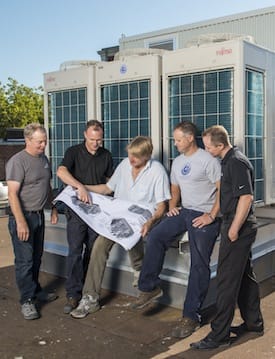
The design and installation crew review isometric drawings of the air VRF-powered multi-zone air handlers. (L-R) Jay Bull, Tim Sykes, Yom Pedersen, Tyler Little, Steve Chamut.
Despite the adequate static pressure capability of the Fujitsu units, Avalon wanted an insurance measure that would eliminate the risk of inadequate flow. A small box was installed just above each duct elbow leading down through the roof. Here, a knockout could facilitate the addition of a booster fan in the future.
“Now, after completion of the project, we realize it was an unnecessary precaution, but it was cheap insurance,” said Pedersen. “With the systems up and running, there’s even better flow than before the retrofit.”
Sykes would periodically check with Tim Young, sales engineer at Fujitsu, on certain aspects of the build, especially in the beginning when they were figuring out how to fit everything into the unit. Support came from the distributor, too.
“Steve Chamut, at Refrigerative Supply was a big asset, as he always is,” said Sykes. “On this job we leaned on him a little harder than usual, considering the nature of it.”
The units were tested and commissioned off site with a generator before being delivered and craned onto the Rithet building; the first one in April and the second a month later. Before delivery, building control rough ins were completed by Kerr Controls Inc. and the power rough ins were completed by Houle Electric. Once on the roof, it took about a day-and-a-half for Capital City Refrigeration to put the units into service.
“We made a few set-point adjustments after the install and that was about it,” said Sykes. “There were no complaints.”
Resounding success
The new air handlers tied into the existing DDC control system with BACnet hardware and software supplied by Fujitsu, allowing offsite control and monitoring. A 3D traffic interface was also installed by Kerr Controls.
The architect involved had to seek blessing from Heritage Society a few times throughout the project. Though the new units were substantially shorter, they were slightly higher, and cabinet flashing material needed to be approved.
In the spirit of maintaining the historical integrity inside as well as out, the building’s old cast-iron radiation remain in place, staged as a secondary heat source through the DDC system. The radiators, which line only the perimeter of the, run at a low temperature when outdoor conditions drop to freezing temps.
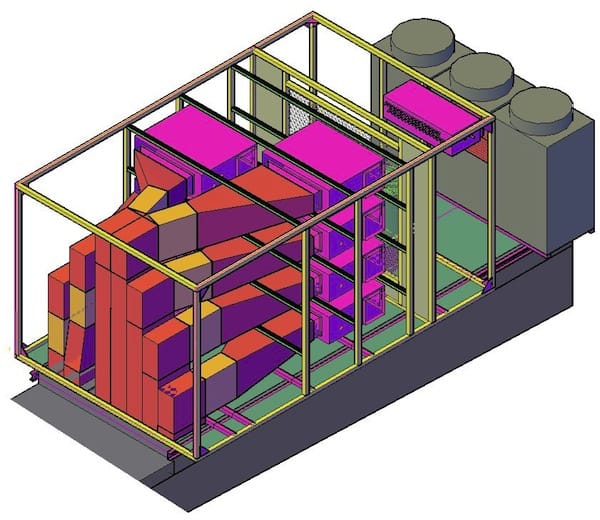
An isometric view of the custom, roof-mounted multi-zone air handlers that now serve the Rithet Building.
The building’s old boilers served both the radiators and the multi-zone hot water coils before the retrofit, and were grossly oversized once VRF assumed the role of supplying primary heat. At the time of the project, these were removed and replaced by a 399 MBH condensing boiler.
“All told, this was not a cheap retrofit alternative,” said Sykes. “But given that the building couldn’t be disturbed and that the exterior had to meet Heritage guidelines, I think it was the very best alternative, especially considering lifecycle costs.”
“Sykes could be a watchmaker,” said Young. “The work that he and the sheet metal sub did on these air handlers is very impressive. This won’t be the last time they build one of these VRF-powered air handlers.”
According to Sykes, they’ve since had three inquiries from other companies about similar retrofits. Both Capital City and Avalon say it’ll go more quickly next time though.
From everyone’s perspective, the project was a resounding success. Hobo Holdings didn’t have any building downtime, the systems are operating as designed, and energy consumption is expected to be similar to that of a geothermal heat pump system.
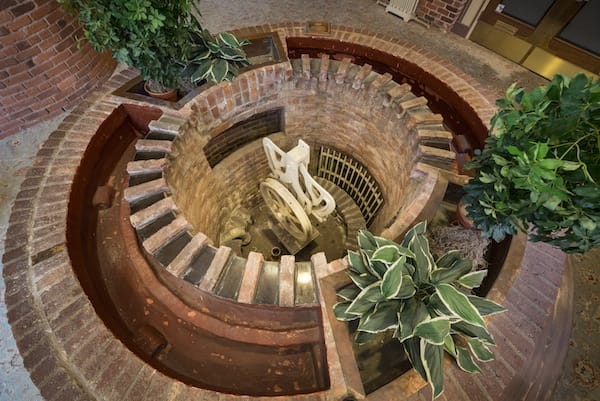
In the lobby of the Rithet Building, the brick well that once served as Fort Victoria’s only water source has been meticulously preserved.




Join the conversation: